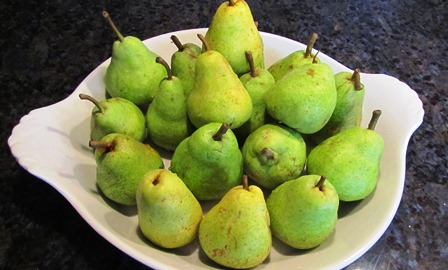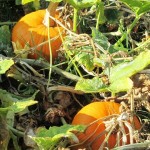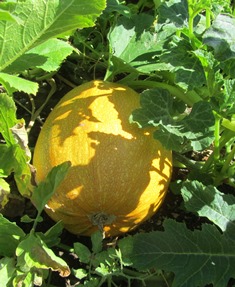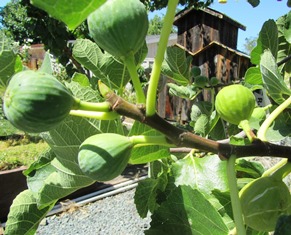Add a Secret Ingredient to Kick-start Your Compost Pile
The leaves of my plum and cherry trees are beginning to drop. The fig leaves have dried to a crisp and are also falling. I’ve got pumpkin and squash vines and stalks of corn pulled and lying in piles in the garden.
This dead, particulate organic matter (detritus) in my garden is too good to throw in the green recycle bin for the city to compost. By composting it myself, I’ll save the money I might spend on buying compost next year.
If your garden has a pile or two of of similar detritus but you’ve had trouble getting it to break down into compost, you might be missing a secret ingredient.
Add one to two cups of a nitrogen-rich garden product like blood meal, bone meal, or cottonseed meal–all are available from your local nursery or garden center.
Follow these simple steps.
1. Dump a wheelbarrow load of leaves where you will be composting this fall and winter. I use a rectangular raised bed.
2. From a cup of blood meal, generously sprinkle the meal onto the leaves.
3. Layer onto the pile grass clippings, pumpkin and squash vines, corn cobs, chicken house straw, dried oats, weeds, and other biomass material.
4. Add more blood meal, more leaves, and more organic material.
5. Sprinkle the remaining blood meal from your cup onto the compost pile and then wet it using a garden hose.
6. Cover with plastic sheeting.
The compost pile generates heat as the plant material breaks down. Thoroughly turn at two or three week intervals. Keep the pile moist (not drenched) and covered.
Using this method, you can expect to have lovely nutrient-rich compost to use on your spring flower and vegetable gardens.
___________________________________________________________________
If you enjoy reading about gardening topics and you are a mystery lover, check out my Henny Penny Farmette series of mysteries from Kensington Publishing. Each charming novel features a wholesome whodunnit along with delicious recipes and farming facts and tips.
Click here to see more: http://tinyurl.com/ya5vhhpm
Join me for “Coffee and Conversation” at Towne Center Books in Pleasanton, The date is Wednesday, October 18, 2017, at 11:00 a.m. The address is: 555 Main Street, Pleasanton, California. Phone is (925) 846-8826.
I’ll be sharing information about my farmette, my mystery-writing process, and my newest novel, A HIVE OF HOMICIDES.
Black Friday Alternatives
I suppose I just didn’t get the shopping gene in my DNA. So while everyone else shops the Black Friday specials, I’ll be doing repairs on a room of our farmhouse. The second bedroom doesn’t yet have the windows completely framed, joint compound and tape on the seams, or plaster on the walls.
It would have been lovely to sleep longer today–this day after Thanksgiving–but our newly adopted cat woke me early. I made coffee and plucked navel oranges from the tree to put into the juicer. After a bagel, coffee, and a glass of juice, I mentally ticked off a list of things I wanted to do today. And I’d get right on those tasks after I watched the sun rise and observed the wild birds foraging at the feeders and the squirrels chasing each other along the fence.
Nature is so seductive, I could have just as easily forgotten my to-do list and stayed outside, enjoying the fresh air and the natural world. I think it’s a terrific idea that many parks in California are waiving fees today to offer individuals and families the option of enjoying nature instead of shopping.
As for shopping, I think life could be much simpler if we just ask a question or two before purchasing: Do I really need it; or, do I just want it? For myself, or someone else?
I know the gift-giving holidays are weeks away. The season of sellers bombarding consumers with “buy” messages is upon us. Call me old-fashioned or blame it on my Midwestern farm-family upbringing, but I prefer to give and receive the gifts of self. Something homemade with love, if possible. Or the gift of time . . . extra hands to help me plant bulbs, put up blood orange jam, paint a room, or pluck eucalyptus leaves to make a holiday wreath.
What do people remember about shopping together? On the other hand, time spent with a friend, a child, or grandchild making a gift or doing something nice for someone can strengthen the bonds of love.
But back to my Friday punch list. I’ve checked my supplies for the day, and it looks like I’m out of Spackle. Arghh! I’ll have to go buy some. But this won’t be an impulse buy–it’s not something I want . . . it’s something I need to finish the job at hand. Enough said.
If you do love shopping and also enjoy reading, check out A BEELINE TO MURDER. See, http://tinyurl.com/p8d6owd
Visit a Farm in the Fall For a U-Pick Experience
The Henny Penny Farmette is about a half hour away from Brentwood. There are at least fifty farms in and around Brentwood that offer families a U-Pick experience. The city is located in the eastern region of the San Francisco Bay Area.
Although Brentwood has had a post office since 1878, the city today is largely residential. That said, there are many actively producing farms and preserved lands around the pockets of community. The area has a semi-arid, Mediterranean climate and is situated on the alluvial plain of the Sacramento-San Joaquin Delta.

To bring out the maximum sweetness of pears, place them in a paper bag for two days in a kitchen cupboard
Many of the farms permit family picking of produce and tree crops. Some of the crops available for picking through October include apples, corn, figs, green beans, onions, peppers, pears, persimmons, pomegranates, pumpkins, squash, strawberries, and tomatoes. Additionally, walnuts, pistachios, and almonds are available year-round at some of the farm stands. There are also wineries and vineyards in the region.
As you drive around the area, look for a Brentwood Harvest Time sign as an indicator for a farm. There will be a number on the sign that coordinates to a name of a farm with that same number on a handily map that you can get at http://www.harvest4you.com. In July, the city hosts a harvest festival for the entire family. It features tractor rides and corn shucking and eating contests, among other activities.
Finally, if Christmas at your house wouldn’t be the same without a live tree, you can find Christmas tree farms in and around Brentwood as well on the Harvest4you.com website. Check it out.
U-pick guidelines as listed on the map include the following rules.
1. No climbing or damaging trees
2. Children are not allowed on ladders.
3. You must buy what you pick.
4. Check produce for ripeness before picking it.
5. Do not throw fruit.
6. Do not litter.
How to Make Homemade Butter
A favorite memory of mine recalls my making butter with my grandmother in her farmhouse kitchen in Boone County, Missouri. All she needed was fresh cream and a jar with a lid.
My grandfather milked the cows and my grandmother would strain the liquid into galvanized cans. After the cream had risen to the top of the milk, she would skim off the cream into smaller cans, storing all of the cans in cool area at the back of the house until my grandfather could take the milk and cream to market. He always kept some back for Rosie’s homemade butter.
The buttermilk that was poured off the would then be chilled. It was his favorite drink after a long, hot day on the tractor working in the fields.
Rosie would hand me a glass jar with a screw top lid in which she’d poured a cup or two of cream and tell me to shake it. My energy and stamina would dictate how long the shaking would have to go on. She’d help. Eventually the butterfat solids and the butter milk would separate.
Rosie favored using a large glass jar with a metal lid that featured a beater and hand crank. Turning the crank beat the cream and amounted to less wear and tear on the arms. Either method worked by separating the liquid from the butterfat.
Today, beating heavy whipping cream (without additives) in a blender or mixer will accomplish the same result. The milk solids eventually become separated from the liquid, which can be poured off. The sweet creamy solid mass can then be salted and even colored if you wish, molded or shaped, chilled, and used. Also, you can leave out the yogurt and still make butter, but it won’t have that tangy flavor.
RECIPE: HOMEMADE CULTURED BUTTER
INGREDIENTS:
1 C heavy whipping cream (no additives)
1 Tablespoon natural, organic yogurt (no additives but with live cultures)
optional: 1/2 teaspoon fine sea salt
DIRECTIONS:
Pour the cream in a small to medium saucepan and warm over low heat to about 90 degrees Fahrenheit.
Stir in yogurt and remove from heat.
Cover and let rest for 24 hours on the kitchen counter to allow the mixture to thicken.
After the cream has thickened, chill in the refrigerator.
Pour chilled mixture into a blender jar or electric mixer bowl.
Beat on a low speed to reduce splatter.
Add salt, if desired.
Beat the liquid and solids separate into massive chunks.
Wrap the butter into a cheesecloth and squeeze over a large bowl to drain out the rest of the liquid. (The buttermilk makes a refreshing drink or can be used to make biscuits).
Mold by pressing the he butter into a plastic mold or an old-fashioned butter molding box. Alternatively, you can shape the butter into small balls using a melon ball scoop.
Hint: To make a flavored butter, add fresh wash, dried, and chopped herbs such as basil and garlic; or cranberries and orange zest. Or, add to the butter apricots or figs (peeled and chopped).
The Figs Are Ripe, Fire Up the Grill
Last night the raccoons raided my fig trees, leaving a little deposit between honeybee apiary and the hen house. I know because this morning, I almost stepped in it . . . and I was barefoot and in still in my pajamas.
It was expecting the raccoons to drop by. It’s that time of the year when they like to show up for a little late night dining. Who can blame them. Figs ripened to perfection are among my favorite fresh foods, too.
Right now, the limbs of my Genoa White Fig hold an abundance of fruit covered in a thin green skin with rose-colored flesh. Whether you prefer to dry figs, make them into jam, use them in a tart, or serve them fresh with a little goat cheese, almost any variety of ripe fig will be delicious. They are an ancient food, dating back thousands of years to Asia Minor. The trees are hardy and can reach 12 to 20 feet tall.
The Brown Turkey, like the White Genoa, is self fertile and produces a multitude of delectable figs by its third year. The skin of Brown Turkey figs turns violet-brown with watermelon-colored flesh when fully ripe. Also, ripe figs turn downward from the limb–it’s how we they’re ready for picking.
I like to serve figs wrapped in Prosciutto, stuffed with a lovely, locally made goat cheese, and grilled. They make a great appetizer when friends drop by this time of year. The figs and goat cheese will pair nicely with a bottle of your favorite wine.
Since we live only about 25 to 30 minutes from the Napa wine country, we tend to buy local.
RECIPE: GRILLED FIGS, GOAT CHEESE, and PROSCIUTTO
Ingredients:
6 to 8 Brown Turkey or other ripe figs
1/3 cup goat cheese (or a bit more as needed; try herb goat cheese as a variation)
6-8 slices of Prosciutto
1/3 cup organic raw honey
Directions:
Fit a pastry bag with a tip to pipe the goat cheese.
Fill the bag with goat cheese.
Cut tiny openings into the bottom of each fig to permit insertion of the piping tip.
Pipe the filling into 8 to 10 figs (they’ll swell; don’t over fill or they’ll split).
Wrap slices of Prosciutto around each stuffed fig.
Brush the grill grate with olive oil.
Grill the figs 2 to 3 minutes.
Remove from heat, plate the figs, and drizzle honey across them.
Serves: 4 (2 figs per person)
 Facebook
Facebook Goodreads
Goodreads LinkedIn
LinkedIn Meera Lester
Meera Lester Twitter
Twitter












